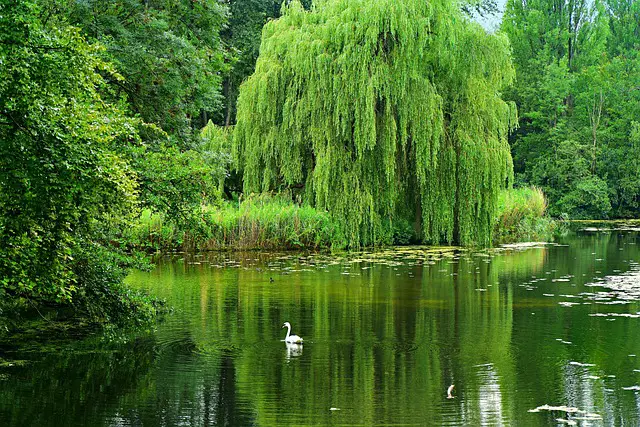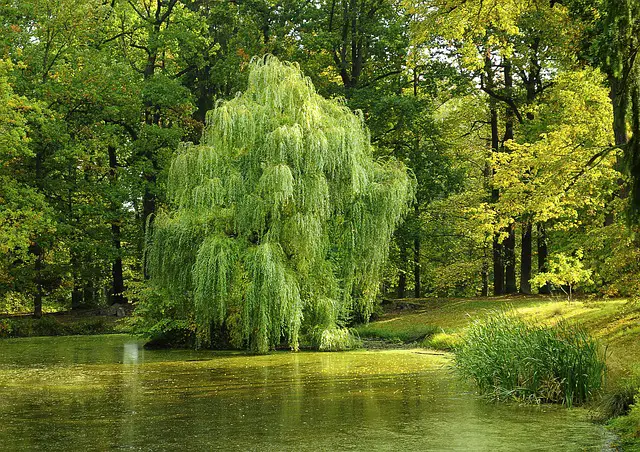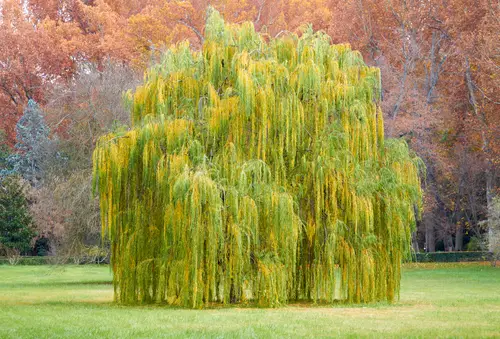Willow trees are known for their graceful appearance and the soothing sound of their leaves rustling in the wind. However, if you notice willow tree leaves turning yellow, it may be a sign of an underlying issue.
Yellow leaves can be an indication of a lack of nutrients, improper watering, or a pest infestation. Understanding the causes and treatments for yellow willow tree leaves can help you maintain the health and beauty of your tree.
Willow trees require specific growing conditions to thrive. They prefer moist soil and plenty of sunlight, but too much water or insufficient drainage can lead to root rot and yellowing leaves.
Additionally, pests such as aphids and spider mites can cause damage to the leaves and lead to discoloration. Identifying the cause of yellowing leaves is crucial to finding the right treatment.
If you’re concerned about yellowing leaves on your willow tree, there are steps you can take to address the issue. From adjusting your watering routine to applying fertilizers or pesticides, there are several treatment options available. With proper care and attention, you can help your willow tree recover and thrive.
Key Takeaways
- Yellow leaves on a willow tree can indicate a lack of nutrients, improper watering, or a pest infestation.
- Understanding the causes of yellow leaves is crucial to finding the right treatment.
- Adjusting your watering routine, applying fertilizers or pesticides, and addressing pests can help your willow tree recover.
Related posts:
- Why Is My Yucca Plant Turning Yellow?
- Serviceberry Leaves Turning Yellow
- San Pedro Cactus Turning Yellow
Understanding Willow Trees

Willow trees are deciduous trees that are known for their graceful appearance and their ability to grow in wet or marshy areas. They are commonly found near bodies of water such as streams, rivers, and lakes.
Willow trees can grow up to 60 feet tall and have a spread of up to 40 feet. They have a distinctive bark that is often gray and deeply furrowed.
Willow trees are known for their long, slender leaves that are typically green in color. However, if you notice that your willow tree’s leaves are turning yellow, this could be a sign of a problem. Yellowing foliage can be caused by a variety of factors including a lack of nutrients, overwatering, or pests and diseases.
Propagation of willow trees is relatively easy and can be done through stem cuttings or by planting seeds. However, it is important to note that not all willow trees are created equal. There are over 400 species of willow trees, and some are better suited for certain growing conditions than others.
In general, willow trees prefer moist, well-drained soil and full sun to partial shade. They are also relatively fast-growing trees, which makes them a popular choice for landscaping. However, it is important to keep in mind that willow trees can be invasive in certain areas and may require regular pruning to keep them under control.
Identifying Yellow Leaves
Yellowing leaves on a willow tree can be an indication of a problem with the tree. Identifying yellow leaves can help diagnose the problem and take appropriate action. Here are some things to look for when identifying yellow leaves on a willow tree:
- Color: Yellow leaves are a clear sign that something is wrong with the tree. The yellowing can be uniform across the entire leaf or may be more pronounced in some areas. In some cases, the leaves may turn brown or black if the problem is not addressed.
- Location: Yellowing leaves can occur on any part of the willow tree, including the branches, trunk, and roots. If the yellowing is localized to a specific area, it may indicate a problem with the roots or soil.
- Texture: The texture of the yellow leaves can also provide clues to the problem. Leaves that are wilted or dry may indicate a lack of water, while leaves that are soft and mushy may indicate a fungal infection.
- Timing: The timing of the yellowing can also provide clues to the problem. If the yellowing occurs in the spring, it may be due to frost damage or a late freeze. If the yellowing occurs in the summer or fall, it may be due to a lack of water or nutrients.
It is important to note that yellowing leaves are not always a sign of a problem with the tree. In some cases, it may be a natural part of the tree’s growth cycle. However, if the yellowing is widespread and severe, it is important to take action to address the problem.
In the next section, we will explore some of the common causes of yellowing leaves on willow trees.
Willow Tree Leaves Turning Yellow – 6 Common Problems

Willow trees are known for their graceful, drooping branches and delicate, green leaves. However, sometimes these leaves can turn yellow, which can be an indication that something is wrong with the tree. Here are some of the common causes of yellow leaves on a willow tree:
1. Diseases and Infections
Yellow leaves on a willow tree can be caused by various diseases and infections. One of the most common diseases that affect willow trees is willow scab, which is caused by a fungus.
Willow scab can cause yellowing of the leaves, as well as black spots and lesions on the bark. Other fungal infections can also cause yellow leaves, such as rust and leaf spot. Bacterial infections can also be the culprit behind yellow leaves.
2. Pest Infestation
Pests can also cause yellow leaves on a willow tree. Aphids, spider mites, caterpillars, and lace bugs are some of the pests that can infest a willow tree and cause yellowing of the leaves. If a pest infestation is suspected, inspect the tree carefully and use insecticidal soap or neem oil to get rid of the pests.
3. Nutrient Deficiencies
Yellow leaves can also be caused by a lack of nutrients in the soil. A willow tree requires nitrogen, phosphorus, and potassium to grow healthy leaves. A soil test can help determine if the soil is lacking in any of these nutrients. If a nutrient deficiency is detected, fertilize the tree with the appropriate fertilizer or soil amendments.
4. Watering Issues
Improper watering can also cause yellow leaves on a willow tree. Overwatering or underwatering can both lead to yellowing of the leaves.
Make sure the tree is getting the right amount of moisture, especially during periods of drought or excessive rainfall. Waterlogged soil can also lead to root problems, which can cause yellowing of the leaves.
5. Poor Drainage and Root Problems
Poor drainage can lead to waterlogged soil, which can cause root problems and yellowing of the leaves. If the soil is not well-draining, consider planting the tree in a different location or amending the soil to improve drainage. Root rot is another problem that can lead to yellow leaves on a willow tree.
6. Environmental Stress
Environmental stress can also cause yellow leaves on a willow tree. Stressful conditions such as drought, excessive heat, or cold temperatures can all lead to yellowing of the leaves. Additionally, chlorosis, which is a condition where the leaves turn yellow due to a lack of chlorophyll, can be caused by stress or a nutrient deficiency.
Treatment and Prevention

Yellowing leaves on willow trees can be an indication of a variety of problems, including disease, pests, nutrient deficiencies, improper watering, and more. In order to treat and prevent yellow leaves on willow trees, it is important to identify the underlying cause and take appropriate action.
1. Disease and Pest Management
Diseases and pests can cause yellowing leaves on willow trees. Fungal infections, such as willow scab, can cause yellow spots on leaves, while insect infestations, such as aphids, can cause leaves to yellow and wilt.
To manage these issues, it is important to identify the specific disease or pest and use appropriate treatments, such as fungicides or insecticidal soap. Neem oil can also be effective in controlling pests, as it disrupts the insect’s life cycle and prevents them from reproducing.
2. Improving Soil and Nutrient Management
Nutrient deficiencies can also cause yellowing leaves on willow trees. To improve soil and nutrient management, it is important to incorporate organic matter, such as compost, into the soil.
Soil amendments, such as bone meal or blood meal, can also be used to provide additional nutrients to the tree. Fertilizer can be used sparingly, as over-fertilization can cause more harm than good.
3. Watering and Drainage Correction
Improper watering and drainage can also cause yellowing leaves on willow trees. To prevent this issue, it is important to water the tree deeply and infrequently, rather than providing frequent shallow watering.
Irrigation systems can also be used to ensure consistent watering. Additionally, it is important to ensure that the tree is not planted in an area with poor drainage, as this can cause water to accumulate around the roots and lead to root rot.
4. Pruning and Care
Pruning can also help prevent yellowing leaves on willow trees. Removing dead or diseased branches can improve the overall health of the tree and prevent the spread of disease. Repotting can also be beneficial for sick willow trees, as it allows for the roots to be inspected and any issues to be addressed.
By taking appropriate action and addressing the underlying cause of yellowing leaves on willow trees, it is possible to prevent further damage and improve the overall health of the tree.
Conclusion

Yellowing of willow tree leaves can be caused by various factors, including a lack of nutrients in the soil, pest or disease infestation, overwatering, or underwatering. It is important to identify the root cause of the problem to ensure the proper course of action is taken to remedy the situation.
One possible cause of yellowing leaves is iron chlorosis, a condition that occurs when the soil pH rises above 7.0. This can be remedied by applying iron supplements to the soil or by lowering the pH level of the soil through the addition of sulfur or other acidifying agents.
Another possible cause of yellowing leaves is a lack of nutrients in the soil. In this case, fertilization with a balanced fertilizer can help provide the necessary nutrients to the tree. It is important to follow the manufacturer’s instructions when applying fertilizer to avoid over-fertilization.
Pest or disease infestation can also cause yellowing of willow tree leaves. Early detection and treatment of the infestation can help prevent further damage to the tree. Insecticides or fungicides may be necessary to eradicate the infestation.
Finally, overwatering or underwatering can cause yellowing of leaves. It is important to ensure that the tree is receiving the appropriate amount of water. A soil moisture meter can be used to determine the moisture level of the soil and ensure that the tree is receiving the proper amount of water.
Frequently Asked Questions
Why are my weeping willow leaves turning yellow with brown spots?
Yellow leaves with brown spots on a weeping willow tree could be a sign of a fungal disease called willow scab. This disease causes brown spots on the leaves, which eventually turn yellow and fall off.
The best way to prevent willow scab is to keep the tree healthy by fertilizing it regularly and watering it deeply during dry spells. If the tree is already infected, it may require treatment with a fungicide.
How do I fix yellow leaves on my tree?
Yellow leaves on a willow tree could be caused by a variety of factors, including overwatering, underwatering, nutrient deficiencies, and pest infestations.
To fix the issue, start by identifying the underlying cause. If the tree is overwatered, reduce watering frequency and ensure proper drainage. If the tree is underwatered, increase watering frequency.
If nutrient deficiencies are suspected, fertilize the tree with a balanced fertilizer. If pests are present, treat the tree with an appropriate insecticide.
Can you overwater a willow tree?
Yes, overwatering a willow tree can cause yellowing leaves, as well as root rot and other problems. It’s important to ensure that the tree is planted in well-draining soil and that the soil is allowed to dry out between waterings.
Water deeply but infrequently, rather than giving the tree frequent shallow waterings.
Do willow trees need lots of water?
Willow trees prefer moist soil, but they don’t necessarily need lots of water. It’s important to strike a balance between keeping the soil moist and avoiding overwatering. Water the tree deeply but infrequently, and ensure that the soil is allowed to dry out between waterings.
Why is my willow pump turning yellow?
Yellow leaves on a willow pup may be a sign of nutrient deficiencies, such as a lack of nitrogen or iron. Fertilize the tree with a balanced fertilizer to address the issue.
Why is my corkscrew willow getting yellow leaves?
Yellow leaves on a corkscrew willow could be caused by a variety of factors, including overwatering, underwatering, nutrient deficiencies, and pest infestations.
Start by identifying the underlying cause and take appropriate steps to address it, such as adjusting watering frequency, fertilizing the tree, or treating it with an insecticide.

Hey, I’m Lisa and I’ve been an avid gardener for over 30 years. I love writing, talking and living in the garden! Feel free to connect with me on my socials below


